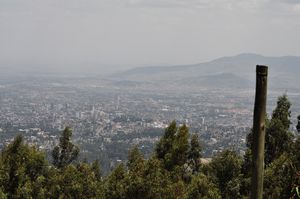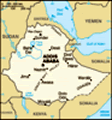Advertisement
Published: June 29th 2012

 Photo 3
Photo 3
Addis from on highI've been in Ethiopia for a little over a week now so I guess it's time to finally add something to the blog. Hopefully I'll get better at updating on a regular basis but needed some time to get my bearings and adjust to life on the road.
My arrival in Addis Ababa was fortunately uneventful and I met Karen and got to her house here in the city pretty easily. She is living with 5 other Emory med students who are working here over the summer at different hospitals in the city. The house they are staying in is much nicer than I expected and feels very western. My sleeping arrangements consist of a closet under the stairs which is kind of funny but actually nice because I'm out of the way of everyone getting up early to go to work. Her roommates are all very nice and fun to hang out with.
Addis Ababa is pretty much what I expected out of a big African city: generally dirty, dusty, chaotic, and full of people. There is a lot of construction going on, both buildings and improvements to roads which adds to the chaos and dust. Not sure

 Photo 2
Photo 2
Not a street I ventured downwhat I would have done without Karen as it is confusing to navigate the city and a taxi is expensive (100 birr which is just under $6) versus the minibus system (3-5 birr which is 15-25 cents). Additionally the streets here don't really have names and there are probably a dozen street name signs in the whole city. Adding to the confusion is the fact that a few years ago they changed many street names from traditional ones to new modern ones (including honoring every country in the AU with their very own dusty road!) but people still use both. The Chinese also donated some street signs when the change occured but they were full of typos which kind of adds a third set of names to the mix. Plus whenever I've asked a local to help show me on a map where I am they have no idea, people just kind of know where they are but don't use maps. I tried to get to a church the other day and walked in the wrong direction for about 30 minutes, then went the right direction but missed the turn which added another 30 minutes of useless walking. On my

 Photo 4
Photo 4
Children, children, children.way back I finally saw it but couldn't really figure out how to get there and was just too tired at that point and just went home. Since it would have probably been the 12th church I've seen here it was probably no big loss.
Ethiopia has a few other strange quirks:
• The Ethiopian year is 7 years behind ours (it's currently 2005 here)
• The calendar has 12 30-day months and a 13 month of either 5 or 6 days (hence a touristy slogan of '13 months of sunshine', which is blatantly not true)
• On the clock, AM is daylight hours and PM is nighttime hours; 6am Western is 12am Ethiopian, noon Western is 6am Ethiopian, and midnight Western is 6pm Ethiopian)
• When talking, Ethiopians use a strange inhaling gasping noise to signal agreement or to kind of ask if you understand. It's startling at first but you get used to it.
Ethiopia is also a surpisingly religious country, with the majority of people belonging to / following the Ethiopian Orthodox Church. The country has been officially Christian since the 4th century and while there is a significant Muslim population as well in some parts,

 Photo 5
Photo 5
Traditional Ethiopian food on njera.the culture is overwhelmingly Christian. Wednesdays and Fridays here are 'fasting' days when Christians are not allowed to eat any meat product. St. George is the patron saint of the country and his image is everywhere in churches, which are abundant. When people pass the churches they cross themselves and pray and many kiss the gates of the church on the street.
As for Addis Ababa itself there aren't that many sights to actually see and I knocked most of them out pretty quickly. It is a very sprawling city with no real geographic or cultural center. There are next to no tourists, to the point that when I see a white person in the city I wonder what they are doing here, and then realize that I am also white and stick out just as much. In fact, most of the westerners here seem to be here to adopt (if it's good for Brangelina, must be good for them too).
Every day in the city you are reminded how lucky you are to have been born in a developed country. The streets are full of child beggars and children selling gum, tissues, and offering shoe shines (the latter employing what seems to be 25% of the under 12 population in the city). You can also catch glimpses down alleys of the slums which are just behind the storefronts and down sidestreets. There are a decent number of polio victims around which is also pretty sad.
Most adult Ethiopians have little patience for the aggressive child beggars who will follow white people for blocks and keep saying 'money, money' or 'birr, birr'. On multiple occasions I have had adults grab child beggars and scold them, telling them to leave me alone. While it is annoying it is really sad to see and you want to give them money but doing so often invites more begging from them and a horde of additional children. There are times when you give a child a few coins and their face does light up and they thank you profusely, which is even sadder because it's the equivalent of a quarter. You do have to look out for the gum and tissue sellers (aka gum thieves) as they are notorious pickpockets. I caught one reaching into my pocket and grabbed his wrist and flung it away, saying no as sternly as I could muster. This spilled his tissues and he said sorry mister and left me alone.
In juxtaposition to all this, and literally within a stone's throw, is the Addis Sheraton. It would be considered an incredibly nice hotel anywhere in the world and has beautiful resort style grounds but one glance over the compound wall and you are looking down into slum style housing.
The highlights in Addis so far have definitely been the food, the coffee, and the people.
Traditional Ethiopian food is very good and is probably best compared to Indian in that there are a variety of meats and vegetables cooked mainly in stew like spiced sauces, eaten with bread. The bread is called njera and is a soft and spongy thin bread that you tear off with your hands and use to scoop up the food and soak in the sauces. Unpracticed faharnjis (their word for white people, which is yelled at you frequently in the street, along with 'hey you'😉 get their hands pretty dirty. The closest thing to a national drink is tej, a honey wine that has a pleasant taste at first but a pretty bad aftertaste. It is definitely an acquired taste but people don't seem to actually drink it all that much.
I have coffee at least 3 times a day here, sometimes traditional Ethiopian coffee (buna) which is dark and pretty strong and sometimes macchiatos, a holdover from the Italians time here.
Ethiopian people are very nice and extremely helpful if you look lost and will help point you in the right direction if they can speak some English (which most do).
Since I've crossed over 1,300 words with this post I think that's about all most of you can tolerate (and probably more). But if we're being completely honest, most of you reading don't really want to go back to work. In the future I'll try and make more digestable posts in line with the attention spans I know I'm working with.
Hope all is well back in the US of A.
- Christian
Advertisement
Tot: 0.068s; Tpl: 0.011s; cc: 9; qc: 49; dbt: 0.0364s; 1; m:domysql w:travelblog (10.17.0.13); sld: 1;
; mem: 1.2mb







